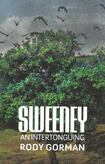
Buile Shuibhne – or Sweeny’s Madness – is a keystone text in medieval literature. After throwing St Rónán Finn’s psalter into a lake, Sweeney is transformed into a bird-like creature, cursed to live in exile, flitting from tree to tree throughout Ireland. Stripped of human comforts, he journeys into madness, and into nature. At every juncture in his wanderings, he creates a poem that describes where he is, and his state of mind.
The text has been reworked by numerous poets, not least by Seamus Heaney in Sweeney Astray. The late Feargal Ó Bearra’s recent Irish version, Mé Suibhne, casts the story as one of mental illness.
Rody Gorman’s Sweeney: An Intertonguing is a multilingual journey like none other – with poems in modern Irish and Scottish Gaelic, as well as English prose versions that burst with startling composite words charged with the homonyms and synonyms of the original Irish. It is an ocean of gorgeous lyric poems, delicate songs and tidal litanies. Poems will often shift language mid-verse. It is peppered with beautiful haiku that nod to the marginal poems of Irish monk scribes as much as to Bashō. Sweeney even becomes the itinerant Japanese haiku poet Santōka Taneda: “ar foluain liom féin/ag éisteacht leis an abhainn/chomh geal agus glan” (“wandering on my own/listening to the river/bright and pure”).
There’s nothing po-faced about Gorman’s Sweeney. Thus he includes the DUP’s Gregory Campbell mocking Irish; a take on Leonard Cohen’s ‘I’m your man’; and sly references to Charlie Haughey, Vincent Van Gogh and Lafcadio Hearn. This is poetry as sonic force, and rewards being read aloud. It’s a celebration of language, whether “King’s English or Inglis or Lallans/Or Scots or Irish or Gaelic/Or Cant, if I’m not all of these,/Then I’m no’ one”. The whole enterprise teems with life; in one scene, there’s a cinematic vision of women pounding flax, church bells ringing, clerics at vespers, and men fishing and swimming.
Finally, Gorman’s Sweeney is the ultimate shape-shifter: he is Orpheus, Merlin, Odysseus; he is a refugee, an outcast; he is the bipolar mind. In his dying, he becomes Whitman’s song of the self, resurrected as poetry itself. And in Gorman’s brilliant reinvention, we are brought into a human, linguistic and poetic world that contains multitudes.














